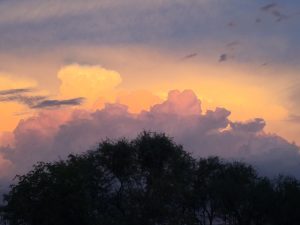By James Thompson
Contributor, EDM Digest
In this podcast, EDM Digest sat down with Captain Derek Williams, Fire Captain and Battalion Safety Officer for the City of Mesa, Arizona. Captain Williams’ firefighting and paramedic career spans more than 25 years, and he offers his firsthand account on the hazards of flash floods, swiftwater rescue and training, and what to do should you encounter a flash flood emergency.
Flash Floods and Extreme Runoff
“Part of the problem we’re having is the loss of vegetation. When you have a wildfire or brushfire and you lose that vegetation, any precipitation you get just runs right off into these creekbeds—some of which haven’t had moisture content like that in almost a decade. So, the loss of vegetation causes extreme runoff; these creekbeds that have been considered dry by a lot of people for years and years flood rapidly and violently.”
Deadly Debris
“Mud, trees, logs, equipment, cars, sometimes even livestock all gets swept up … A lot of people have the perception—I’ll have time to walk out of it or swim out of it. Well, it’s not water per se, it’s more of a horizontal mudslide [of debris] and these things change so rapidly.”
Extreme, Sudden Changes
“You can have clear skies above you and beautiful weather, and 20, 30 miles, 40 miles away there is this dump of precipitation that happens in a concentrated area rapidly, and that’s what causes the flash flood, and you have no idea that thing is coming at you.”
[Related: Flash floods hit Midwest and East Coast]
Knowing the Warning Signs
“A lot of firsthand accounts of people who survived flash floods said that the first thing they heard was the noise; it sounded almost like a freight train coming at them, and by the time you hear that, you’re almost in the danger zone, and it’s almost too late. You just have no perception that anything dangerous could be affecting you because these events are happening miles and miles away, and it takes some time for that water and that mud and debris to get to you – that’s absolutely a danger.”

Phoenix Flood Zones
“Year after year, you’ll see on the news that we end up with several rescues out of vehicles in the Phoenix metropolitan area; there’s areas of Phoenix, Scottsdale, Mesa that all have roadways that go through these flood zones and they do have signs and we do try our best to get the barricades up. We’ve had some instances where people underestimate that power of the water and will drive right around the barricade and put themselves in harm’s way. Hence, we have the – I believe it’s called – the ‘Stupid Motorists Law’ whereby those people will incur charges for their rescue.”
Swiftwater Certification Training
“There are strong swimmers classes; swiftwater rescue classes. The swiftwater training I took, as part of my technical rescue training was about six days long. It was very specific to swiftwater rescue training. You start off with the simple things like bankside rescues, with throw-bags and throw-rings, and helping people self-rescue; talking them into self-rescue … and you work up over the course of six days through various strong swimmers manipulating rafts for rescues – things of that nature – all the way up to offloads on rotor aircraft, to helicopters, to affect a rescue.” [relink url=”https://amuedge.com/14-killed-by-storms-and-flooding-in-south-and-midwest/” url2=”https://amuedge.com/floods-planning-and-preparedness/” url3=”https://amuedge.com/californias-robust-mountain-snowpack-boosts-flood-concerns/”]
“One of the biggest things I took away from the swiftwater rescue training was negotiating the ‘snags,’ the ‘riverbank snags,’ and what I mean by that is entrapment areas such as trees and brush that are on the riverbanks, and as you’re going down, you get caught in those. And, I probably really didn’t have a true understanding of the power of water until we had that training … Until I had that training, I was probably very naïve in the power of water to manipulate your body and to overcome your muscular strength, to save yourself. So, that was a very eye-opening experience.”
Captain Derek Williams serves as the Mesa, Arizona Fire and Medical Department (MFMD) Battalion 203 Safety Officer in Mesa, Arizona. Over his 25-year firefighter-paramedic career, Captain Williams earned certifications from the State of Arizona, FDSOA, and FEMA as a Fire Department Incident Safety Officer (ISO), and Fire Department Health/Wellness and Safety Officer (HSO). Captain Williams is an author and instructor, and he is currently researching and studying in the Emergency and Disaster Management program at American Military University.
